Do you have a heartworm positive dog undergoing treatment? Have you been told to restrict exercise or told about keeping heartworm positive dogs calm during heartworm treatment? Are you worried about keeping your dog calm during heartworm treatment?
I know just how you feel.
I’ve taken several foster dogs through heartworm treatment and I’m always worried about the challenges of keeping dogs calm during heartworm treatment.
[The view shared here is not a replacement for the advice and direction of your veterinarian. Every heartworm-positive dog is different and may require a very specific protocol. I only share what has worked for me for a small number of dogs undergoing melarsomine therapy.]
Don’t let your fear of keeping dogs calm during heartworm treatment influence your treatment choices.
Let’s face it: The thought of keeping your active dog calm during heartworm treatment may want you to shy away from “fast-kill” therapies. I understand! Melarsomine treatment is risky and scary.
The more I understand about heartworm disease and treatment, however, the less I’m afraid of “fast-kill” treatment.
Any heartworm treatment protocol requires planning, commitment, and attention.
But wait – slow-kill is easy, right? Not really, says the American Heartworm Society. “Slow-kill is slow,” says Dr. Clarke Atkins, DACVIM. As long as heartworms are in the dog (up to 30 months with the traditional slow-kill protocol) those worms cause damage. Slow-kill protocols also require exercise restriction for the dog. Why? The answer is straight forward: exercise causes more damage. The American Heartworm Society urges all dogs diagnosed heartworm positive to begin exercise restriction, no matter which treatment protocol you choose to use.
How do I keep my foster dogs calm and happy during both the exercise restriction and cage rest phases of heartworm treatment? Keep reading!
I’ve Followed Both Fast-Kill and Slow-Kill Heartworm Treatment Protocols
I’ve fostered a half-dozen (or more) dogs who were diagnosed heartworm positive. Only one received slow-kill treatment, Emmy Lou. She was my crate aversive, please-don’t-leave-me-alone deaf female that lived with me for about two years. Her issues made it unsafe for her to undergo melarsomine therapy because I was unable to keep her calm.
Emmy Lou hated the crate. When you closed the crate door, she anxiously worked herself up into a frenzy. I tried to gently train her to the crate, but she was steadfast in her resistance. Sedatives did not ease her anxiety, either. Even though she had an early stage of heartworm disease, melarsomine therapy was unsafe, as Emmy Lou would not tolerate cage rest. The safer treatment for her was a slow-kill protocol.
Emmy Lou’s slow-kill protocol included the use of Doxycycline and a monthly dose of Heartgard. After testing negative for heartworm, she was adopted by a wonderful family and lived the life of a queen. She died at the age of 11 from a cardiac event. I wish she’d had more time to soak in all the doting she received and deserved.
The Difference Between Exercise Restriction and Cage Rest
The ultimate difference between exercise restriction and cage rest is defined by your veterinarian after a full workup is complete. The American Heartworm Society does state that exercise restriction should begin the same day the diagnosis is confirmed.
Usually, my vet instructs me to keep my heartworm positive dog from engaging in any activity that elevates the heart rate until the end of treatment. So, while my dogs can move more freely around the house during exercise restriction, they still cannot run, play fetch, or go for a long, strenuous walk. Because my yard is full of squirrels and chipmunks, I usually begin requiring heartworm positive dogs remain on leash for outdoor potty breaks.
After the dog begins receiving the melarsomine injections, my veterinarian instructs me to begin pretty strict cage rest. When the dog is not with me on leash, the dog is to be secured in a crate or exercise pen, or in a small room behind a baby gate. Even walking around the house or jumping off the bed or going up a flight of stairs can be enough exercise to cause complications.
Recently, I read a really good explanation of exercise or activity restriction. She wrote: “It isn’t really activity restriction. It is heart rate restriction. You are to restrict the heart rate from increasing.”
Keeping Dogs Calm During Heartworm Treatment
How I Restrict Exercise
During exercise restriction, I stop the following activities:
- I keep dogs from running up and down the stairs. Instead, we walk up/down the stairs at a normal pace.
- I stop brisk, long walks and replace them with shorter, leisurely “sniffing” walks.
- I put away the fetch ball.
- I crate all dogs before I answer the front door.
- I leash walk the heartworm-positive dog outdoors for potty time using a longer lead.
- I do not allow games of chase or wrestle.
- I manage how much jumping up/down off furniture happens.
- I anticipate zoomies all.the.time. so I can prevent them. I foster Boston terriers, usually. They zoomie often!
How I Cage Rest During Heartworm Treatment
Cage rest is pretty self-explanatory. It means cage rest! Your heartworm positive dog, after receiving melarsomine treatment will be instructed to remain caged, crated or penned for the duration of this phase of treatment except when they need to go outside to potty or when you can absolutely-positively-guarantee that your dog will remain calm.
The duration of this phase may be as short as 30 days, or as long as 120 days, but most of my foster dogs were under cage rest for 60 days.
I always “size up” the crate for cage rest. The goal is to keep their body “at rest”, not immobile. Your heartworm positive dog should be able to stretch out and lay comfortably in any position they choose. At a minimum, they should be able to stand up and easily turn around while in the crate.
During cage rest, I stop the following activities:
- continue all of the exercise restriction activities already implemented.
- stop all walks except potty strolls in the back yard.
- stop all play and active training that will encourage excitability.
- do not allow the heartworm positive dog to have any free reign in the home or yard.
- throttle down the activity of the other dogs in the home.
How I Keep My Heartworm-Positive Dogs Happy During Exercise Restriction and Cage Rest
During the exercise restriction phase I:
- give my dogs several, short leash walks during the off-temperature times of the day. These are SHORT walks, 10 minutes max at a leisurely pace.
- provide more exploration and sniffing activities than actual walking. Sniffing is an enrichment activity, good for the dog’s nose, brain, and mood! (Check out this link for DIY snuffle mats!)
- practice carefully chosen obedience training skills indoors, or if outdoors, controlled. This works! As long as your dog is not becoming overly excited about food rewards, you can really wear your dog out by a 15-minute training session.
- teach impulse control work. An example is, teaching a dog to hold a sit or a stay for longer and longer periods of time until it’s released.
- use enrichment toys, carefully chosen. Active enrichment toys might be too active, so I use toys like the Kong Classic dog toy – ones that allow the dog to quietly work to get the food out.
During the cage rest phase for non-symptomatic dogs:
- I continue to use enrichment toys
- If I conduct training sessions, it is very controlled and very stationary. Training I might do: “leave it”, “take it”, “give it”, “drop it” cues where the dog does not have to move about.
- I make sure heartworm positive dogs are crated near other calm dogs when I’m not home. Cage rest does not have to mean isolation. They need to feel connected, not alone.
- I allow short breaks for a stroll around the yard and continue to encourage sniffing and gentle exploration.
- If it’s a pretty day and my dog is calm, I may sit outside on the porch with my heartworm positive dog tethered next to me for a bit.
- In the evening, when all is quiet and if the heartworm positive dog can tolerate, I allow a dog to join me on the sofa for quiet time. The dog is on a leash and the dog is tethered to me. My other dogs are also in a calm state of mind or they are crated in a different part of the house.
What About My Other Dogs?
I think that my personal dogs are affected when I have a heartworm positive dog in my home. I know they are because I change their routine too!
I find that it is much easier keeping dogs calm during heartworm treatment when all dogs in the house are asked to somewhat restrict their activity.
Here’s how:
- I change where we play active games. If I normally allow fetch and tussle games inside, I direct those activities outside, so my heartworm positive dog cannot see or hear the play happening. How unfair to a caged dog to see play and not be able to participate!
- All dogs are fed in their crates. I think if my heartworm positive dog is fed in their crate, my other dogs should, too.
- I restrict window access and door access to all dogs. How upsetting to a caged dog to hear commotion when the UPS driver approaches the house and not understand what’s happening?
In other words, a caged dog is going to experience some frustration just by the nature of being confined. I don’t want to add to that frustration because my other dogs are allowed to participate in normal rowdy dog activities right under its nose.
Additional Thoughts
If your dog rescue agency follows the American Heartworm Society’s melarsomine protocol, you have some time to assess your heartworm positive foster dog’s tolerance to confinement. If your dog seems to have issues with confinement, TALK WITH YOUR VETERINARIAN. Medications may help. Most medications won’t gork your dog but instead can help a dog relax.
Honestly? Your foster dog will probably feel less energetic after melarsomine therapy. That’s a good thing! I find my foster dogs have the hardest time being restricted during the final two weeks or so following the two back-to-back injections. The worms are mostly all dead and being absorbed, the body is less inflamed, and the dog’s health is on its way to its new baseline. That’s when keeping dogs calm during heartworm treatment is more challenging for me.
Keeping your dog calm while undergoing heartworm treatment sounds worse than it is. Your dog is more flexible than you think they are. Start dialing down the activity level the first day you learn your dog is heartworm positive. Redefine fun and give them those opportunities in replacement for those rowdy games of fetch and wrestling. Use this time to teach your dog that they can be content when it’s time to settle.
4-6 months can sound like a lifetime. In truth, it goes by faster than you think it will. Good luck. You are in my heart as you journey through this.
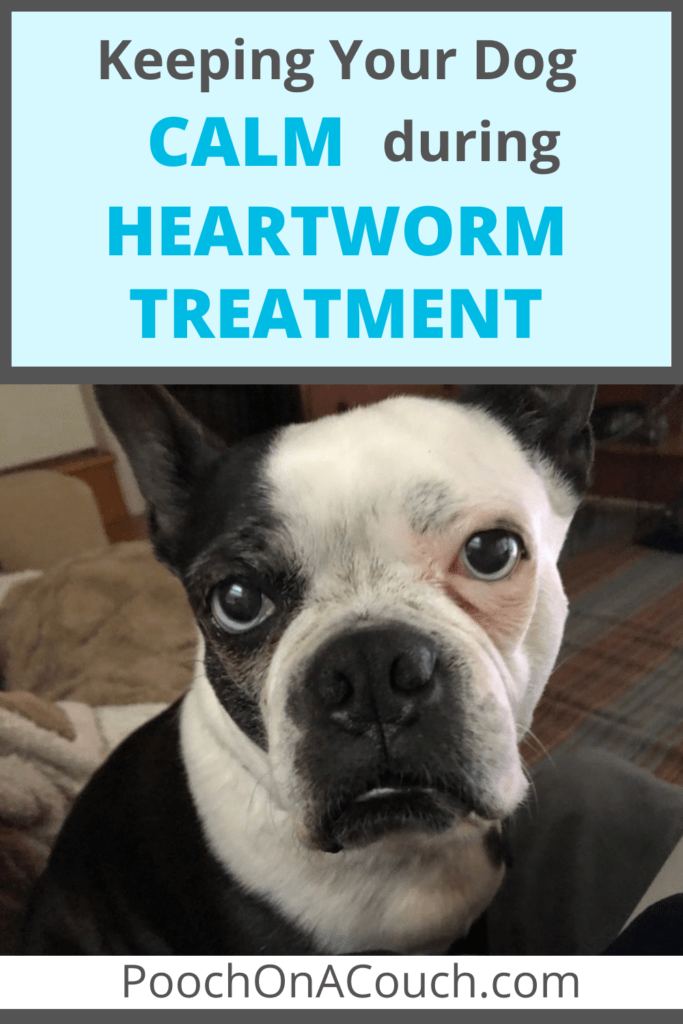
More Resources
Dog in a Box: Battle boredom with comfortable quiet time
Battling Boredom: Tips for Surviving Cage Rest
Did You Miss These Posts?
Give Doxycycline to Heartworm-Positive Dogs
Why Heartworm-Positive Dogs Should Not Exercise
Caval Syndrome: Hank Beat The Odds


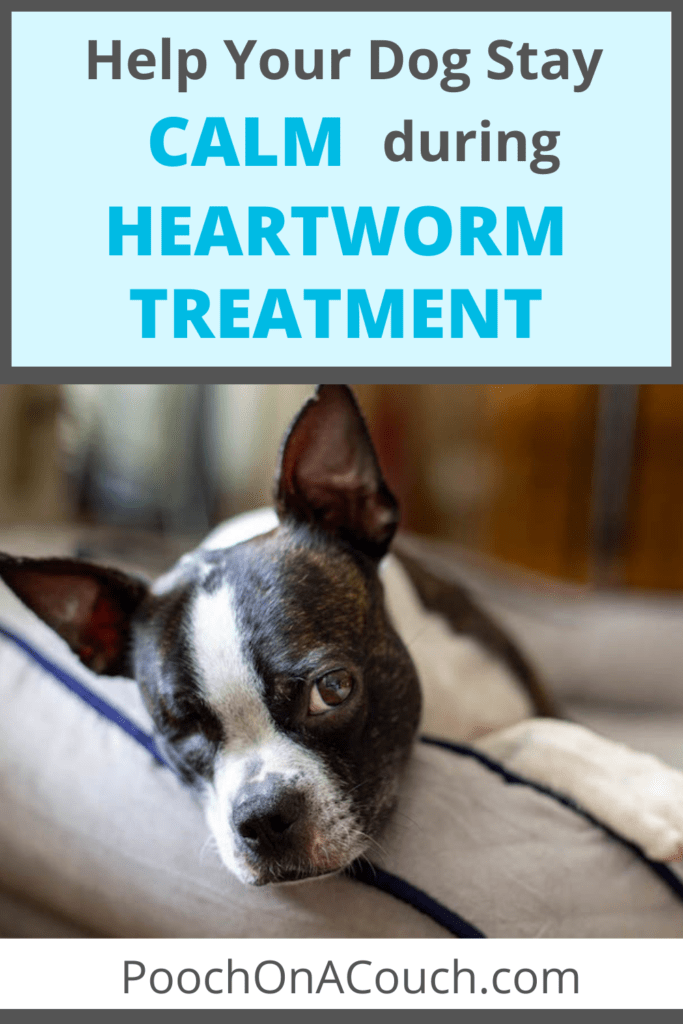
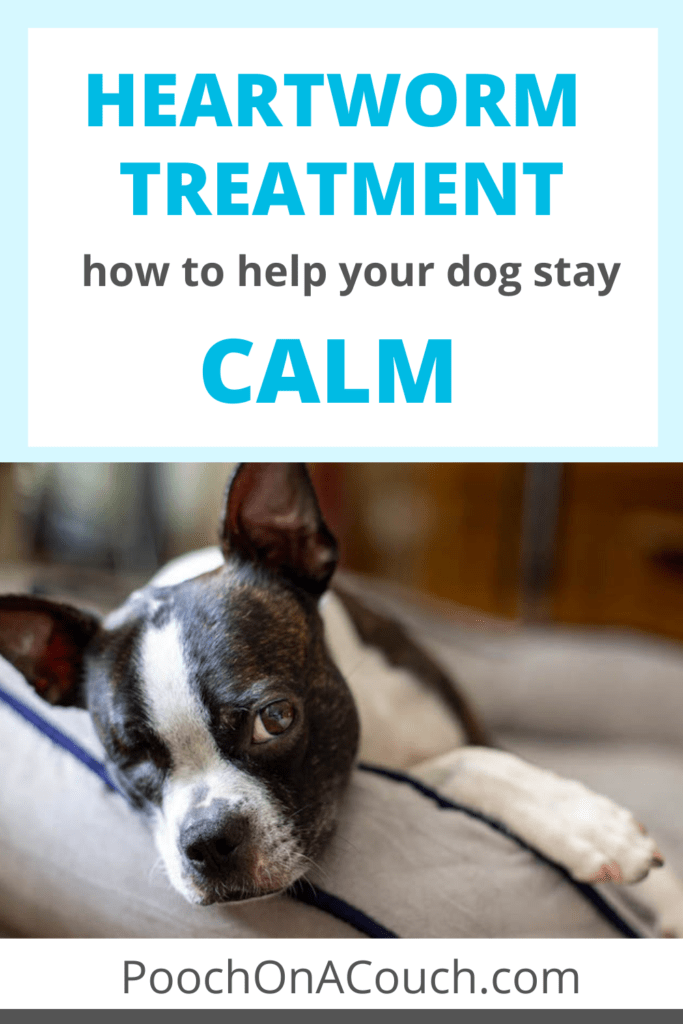
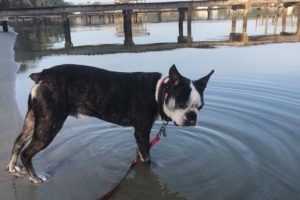
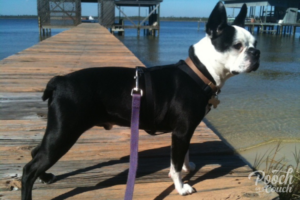

I don’t have any experience with dogs with heartworm. There was a cat at the shelter where I volunteer with heartworm. He was transferred up to us after Hurricane Katrina. I don’t remember it was fast kill or slow kill, but he did have to live in a cage and stay calm for quite some time.
Such a great, informative post. I’m going to share!